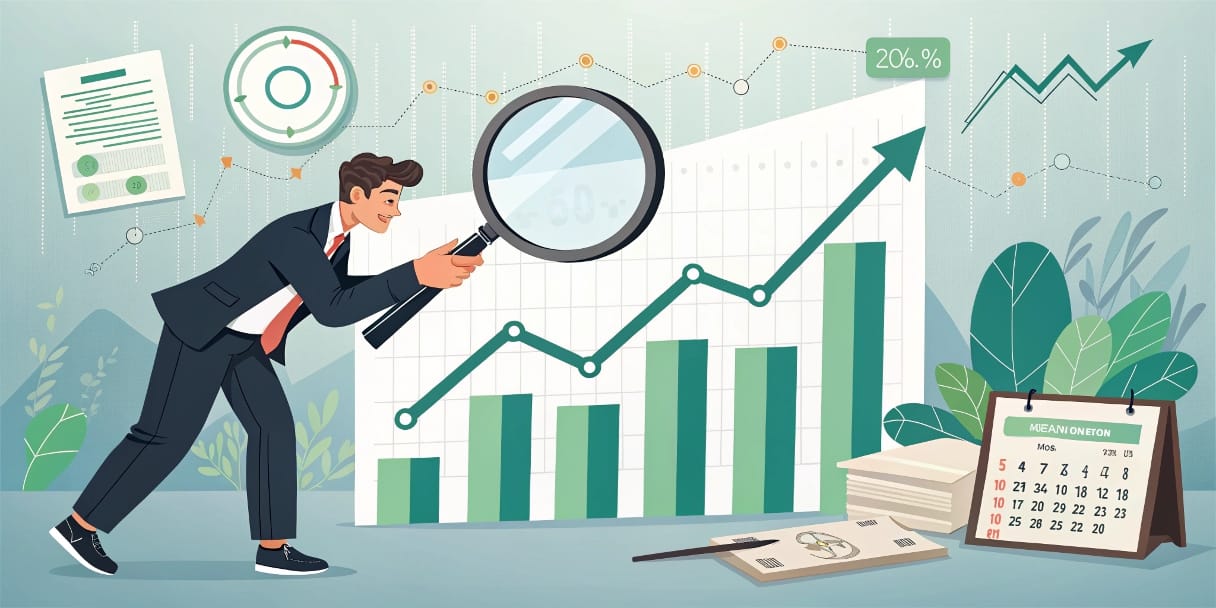Understanding profitability isn’t just about crunching numbers — it’s one of the most powerful tools you have to guide your business toward success. Whether you run a physical store, a consultancy, or an e-commerce business, knowing whether each product, service, or project is actually making you money is key to making smart decisions.
At MiNegocioTop.com, drawing from real-world experience managing and optimizing small and medium-sized businesses, we demystify profitability analysis. We’ll share proven methods and exclusive tips to help you use your finances as your strongest ally for boosting profits. Get ready to see your numbers clearly — and take action.
Why Understanding Profitability Is Crucial for Your Business

Many businesses focus solely on increasing sales — and that’s great! But selling a lot without understanding profitability is like pouring water into a leaky bucket: no matter how much you add, it keeps slipping away.
Knowing if your business is truly profitable lets you:
- Make smarter decisions: Should you invest more in ads for a specific product? Is it time to hire someone? Is a new service worth offering? The answers lie in your numbers.
- Identify money leaks: Find out which products, services, or processes aren’t efficient and where you’re losing money without realizing it.
- Prioritize effectively: Focus your energy on what brings in the most profit, and cut or improve what causes losses.
- Negotiate better: Knowing your costs and margins gives you leverage when setting prices or negotiating with suppliers.
- Ensure sustainability: A profitable business is more likely to grow, innovate, and survive tough market conditions.
At MiNegocioTop.com, we say profitability is the oxygen of your business — we help you measure it so you can breathe easier.
The MiNegocioTop Method for Profitability Analysis
Here’s how we break down profitability calculation so it’s practical and useful for your business.
How to Calculate the Real Profitability of a Product or Service
Not all sales are equally profitable. To know if a product or service is making you money, you need to calculate its net profit margin. It’s simpler than it sounds:
Revenue per Sale – Direct Costs = Gross Profit
Gross Profit – Attributed Indirect Costs = Net Profit (Profitability)
Example: Product Profitability Calculator
- Sale Price: $50.00
- Production Cost: $20.00
- Sales Commission: $5.00
- Indirect Costs (allocated): $3.00
Results:
- Total Direct Costs: $25.00
- Gross Profit: $25.00
- Net Profit: $22.00
This allows you to compare which products or services are more profitable — and which ones might need a price or cost adjustment.
Break-Even Point Analysis: How Much You Need to Sell to Avoid Losses
The break-even point is the sales volume (units or revenue) at which your business neither loses nor makes money. Knowing this is crucial for strategic planning.
Basic Formula:
Total Fixed Costs / (Unit Sale Price – Unit Variable Cost) = Break-Even Point (Units)
- Fixed Costs: Costs you pay no matter what (e.g., rent, salaries, software).
- Variable Costs: Costs that change per sale (e.g., raw materials, shipping).
Break-Even Calculator Example
- Fixed Costs: $5,000
- Variable Cost per Unit: $15.00
- Selling Price per Unit: $25.00
Results:
- Break-Even (Units): 500
- Break-Even (Revenue): $12,500.00
- Contribution Margin: $10.00
MiNegocioTop Tip: Recalculate your break-even point regularly — especially before launching a new product or if your costs change. It gives you a clear sales target to avoid losses.
Profit Margin vs. Profitability: Not the Same, But Both Matter
It’s common to confuse profit margin with profitability, but they’re different concepts:
| Feature | Profit Margin (Gross) | Profitability (Net) |
|---|---|---|
| Focus | Per product/service or sale | Overall business financial health |
| Included Costs | Only direct costs (production, acquisition) | All costs and expenses (direct + indirect) |
| Purpose | Evaluate product viability, pricing | Evaluate overall business success |
- Gross Profit Margin = (Revenue – Direct Costs) / Revenue × 100
- Net Profitability = (Net Profit / Total Revenue) × 100
MiNegocioTop Tip: A high margin is great, but your net profitability is what really counts. You might have a profitable product, but if your operating costs are too high, your business may still be losing money. Look at the big picture.
Key Financial KPIs Beyond Revenue
Tracking revenue alone isn’t enough. Here are essential financial KPIs to monitor:
- Net Profit Margin: How much actual profit remains after all expenses?
- Return on Investment (ROI): How effective is a specific investment?
Formula: (Investment Gain – Investment Cost) / Investment Cost × 100 - Customer Acquisition Cost (CAC): How much does it cost to gain a new customer?
- Customer Lifetime Value (LTV): Total revenue expected from a customer over their lifetime.
- Current Ratio (Liquidity Ratio): Can you pay short-term debts?
Formula: Current Assets / Current Liabilities
MiNegocioTop Tip: Focus on 3–5 relevant KPIs. Don’t overwhelm yourself — fewer, well-tracked indicators are more effective.
How to Read a Basic Balance Sheet (No Accountant Needed)
A balance sheet is a snapshot of your business’s financial health. Here’s how to read the basics:
Key Components:
- Assets: What your business owns (cash, inventory, property).
- Current Assets: Convert to cash within 12 months.
- Non-Current Assets: Long-term assets (equipment, property).
- Liabilities: What your business owes (loans, payables).
- Current Liabilities: Due within 12 months.
- Long-Term Liabilities: Payable after 12 months.
- Equity: What’s left after liabilities — owner investment + retained earnings.
Fundamental Equation:
Assets = Liabilities + Owner’s Equity
MiNegocioTop Tip: Review your balance sheet at least annually (or semi-annually if growing fast). It shows financial strength and whether you’re building value.
AI as a Tool for Financial Analysis
AI can help simplify and enhance your business’s financial analysis:
- Data Processing: AI can handle large volumes of financial data quickly.
- Pattern Detection: Identify spending trends or anomalies.
- Financial Forecasting: Generate basic projections using historical data.
- Automated Reports: Save time with auto-generated financial summaries.
AI is a support tool — your strategic judgment is still the key to making smart business decisions.
The Ultimate Goal of Profitability Analysis
At MiNegocioTop.com, profitability analysis isn’t just accounting — it’s a growth strategy.
Use it to:
- Identify what truly drives your profit.
- Optimize pricing and cost structures.
- Make smarter investments.
- Strengthen your business’s financial health.
- Grow sustainably and consistently.
Let your financial analysis shine a light on your path to success.
Quick Finance & Profitability Tips from Our Experience
Tip 1: Be Disciplined with Recordkeeping
Keep track of income and expenses regularly — even a spreadsheet helps. Clarity = power.
Tip 2: Review Costs Quarterly
Are you paying for unused subscriptions? Can you renegotiate rates? Small savings = bigger profit.
Tip 3: Don’t Just Copy Prices
Price based on your actual costs and desired margins. Competing on price alone doesn’t guarantee profitability.
Tip 4: Monitor Cash Flow Weekly
Being “profitable on paper” doesn’t help if cash doesn’t flow. Cash flow is the lifeline of your business.
Your Common Questions About Profitability — Answered
What’s the difference between revenue and profitability?
Revenue is total income from sales. Profitability is what’s left after all costs. High revenue means nothing if expenses eat it all.
Do I need an accountant to calculate profitability?
For basic analysis, no. You can do it using the methods here. For tax or advanced planning, an accountant helps — but you should still understand the key concepts.
How can I improve profitability if sales are flat?
Focus on:
- Cutting unnecessary costs
- Improving pricing strategies
- Boosting operational efficiency
- Increasing customer loyalty
Is ROI the same as profitability?
Not exactly. ROI measures the return from a specific investment. Profitability measures overall business performance. Both are essential.
Your Next Step Toward a More Profitable Business
Learning to calculate and analyze profitability is more than a skill — it’s a superpower for business owners. It gives you the clarity and control to thrive.
We’ve covered the essentials — from profitability formulas to balance sheets. To go deeper into each topic (like cash flow or cost optimization), check out our [Finance & Profitability for Business Hub].
Profitability isn’t luck — it’s the result of smart, informed decisions.
At MiNegocioTop.com, we give you the tools. Free.
[ Explore More Finance Strategies for Your Business ]

